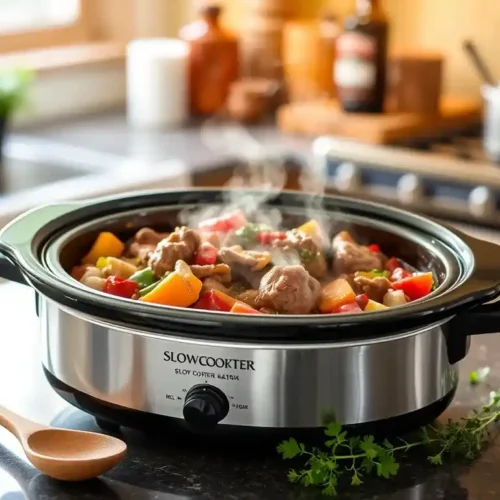
2 qt slow cooker recipes
Save time and enjoy delicious meals with this 2-qt-slow-cooker guide. Perfect for small-batch cooking, easy dinners, and flavorful, hassle-free recipes!
Ingredients
Protein Choices for a Satisfying Dish
- Boneless skinless chicken breasts or thighs for juicy, tender results
- Lean beef cuts such as chuck roast or stew meat for a hearty dish
- Ground turkey or chicken for a lighter alternative
- Plant-based proteins like lentils chickpeas, or tofu for vegetarian meals
Vegetables for Flavor and Nutrition
- Vegetables not only enhance the flavor of a slow cooker meal but also add color texture, and essential nutrients. Since slow cooking softens vegetables over time, choosing the right ones ensures the best consistency. Some great options include:
- Root vegetables such as carrots potatoes, and sweet potatoes for heartiness
- Bell peppers and onions for added depth and natural sweetness
- Mushrooms for a meaty texture and umami flavor
- Leafy greens like spinach or kale added at the end for freshness
- Zucchini squash, or green beans for lighter, fiber-rich additions
Flavor Enhancers for Depth and Complexity
- A great slow cooker meal relies on layers of flavor that develop over time. Adding the right seasoning and liquid components ensures a well-balanced and delicious dish. Key flavor boosters include:
- Garlic and onions for a savory base
- Fresh or dried herbs such as thyme rosemary, or oregano for aromatic depth
- Spices like paprika cumin, or cinnamon for warmth and complexity
- Tomato paste or diced tomatoes for acidity and richness
- Worcestershire sauce soy sauce, or balsamic vinegar for umami balance
- A small amount of honey or maple syrup for subtle sweetness
Broth and Liquid Essentials
- Slow cooking requires enough liquid to keep the dish moist and flavorful without making it too watery. The type of liquid you use can dramatically influence the final taste. Consider these options:
- Low-sodium chicken beef, or vegetable broth for a well-rounded base
- Coconut milk for a creamy and slightly sweet element in curries or soups
- Crushed tomatoes or tomato sauce for a rich and hearty texture
- Dry white wine or apple cider for a hint of acidity and brightness
- Water with a bouillon cube for a budget-friendly alternative
Whole Grains, Beans, and Pasta for Hearty Texture
- If you want to make your slow cooker meal more filling adding grains or legumes is a great way to enhance texture and provide extra fiber. Keep in mind that grains absorb liquid and should be added at the right time. Some top choices include:
- Brown rice or quinoa for a wholesome base
- Barley for a chewy and nutty flavor
- Lentils for plant-based protein and heartiness
- Black beans kidney beans, or chickpeas for added substance
- Small pasta like orzo or macaroni stirred in during the last 30 minutes to prevent overcooking
Instructions
Prepare the Ingredients for Maximum Flavor
- Before adding ingredients to the slow cooker, a little preparation goes a long way in enhancing the dish’s taste and texture.
- Wash and chop all vegetables into even sizes to ensure uniform cooking.
- Trim excess fat from meats to avoid overly greasy results.
- If using beans or grains, pre-soak them if needed to ensure proper cooking.
Layer Ingredients in the Right Order
- Proper layering in a slow cooker ensures that all components cook evenly and absorb the flavors effectively.
- Hearty vegetables like potatoes, carrots, and onions should go in first since they take longer to soften.
- Proteins such as chicken, beef, or tofu should be placed on top of the vegetables to allow them to soak up the juices as they cook.
- Seasonings, herbs, and spices should be evenly sprinkled over the ingredients to distribute flavors properly.
- Liquids like broth, tomato sauce, or coconut milk should be poured over the top to ensure everything stays moist and infused with flavor.
Choose the Right Cooking Temperature and Time
- Cooking times in a slow cooker can vary depending on the recipe and ingredients used.
- Low setting (6-8 hours) is best for tougher meats, beans, and slow-simmered stews that need extra time to break down and develop deep flavors.
- High setting (3-4 hours) works well for quicker meals with tender ingredients like chicken breast, seafood, or delicate vegetables.
- Avoid lifting the lid too often as this releases heat and can extend cooking time unnecessarily.
Stir Only When Necessary
- Unlike stovetop cooking, slow cooker meals do not require frequent stirring. Stirring too often can lead to uneven cooking or breaking down delicate ingredients like beans or grains. If a recipe requires stirring, do so only in the last hour of cooking.
Adjust the Seasoning at the End
- Slow cooking can mellow out seasonings over time, so it is best to taste the dish before serving and make final adjustments.
- If the dish tastes too mild, add a pinch of salt, a squeeze of lemon, or a dash of hot sauce for extra depth.
- For richer flavors, stir in fresh herbs like basil, cilantro, or parsley just before serving.
- If the sauce is too thin, remove the lid and cook on high for 20-30 minutes to allow excess liquid to evaporate.
Let the Meal Rest Before Serving
- Once the slow cooker has finished cooking, allow the meal to sit for about 10 minutes before serving. This resting period helps redistribute juices and ensures a balanced, well-rounded flavor in every bite.
Notes
Nutrition Information (Per Serving)
- Calories: ~350
- Total Fat: 12g
- Saturated Fat: 3g
- Protein: 28g
- Carbohydrates: 30g
- Fiber: 5g
- Sugar: 6g
- Sodium: 450mg
Recipe Categories
- Course: Main Course
- Cuisine: American, Comfort Food
- Diet: Gluten-Free, High-Protein, Low-Carb (with modifications)
- Method: Slow Cooker
- Keyword: 2-qt slow cooker, easy slow cooker meals, small-batch slow cooking, healthy crockpot recipes
- Skill Level: Beginner-Friendly